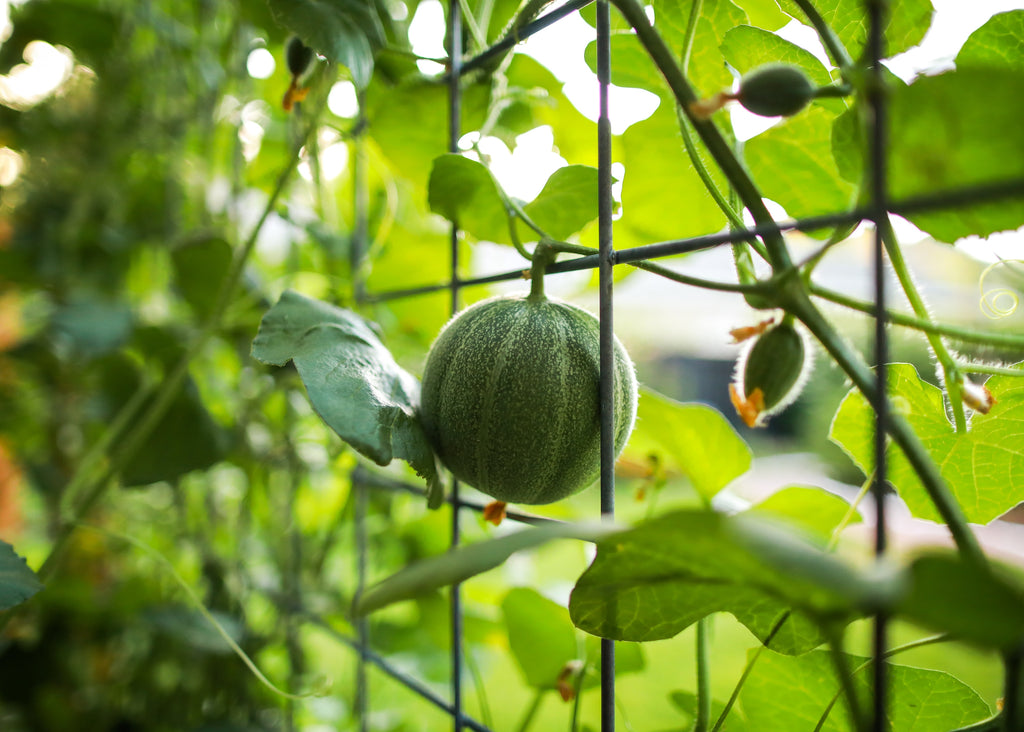At long last it is time to plant Melons. This time truly represents a shift in the growing season. The sun and longer days lead to a burst of growth in the garden. The soil is getting warmer and more habitable for our favorite summer friends.
We are still a couple weeks before our last frost date in Southern Oregon. Sometimes our last frost date is fickle. If yours is too, pay attention to the weather reports and try to time your plantings accordingly. Gardening is a waiting game and even though I won’t be eating Melon for another few months, I am eager to get started watching the plants grow.
Melons are members of the Cucurbitaceae family, sometimes called the gourd family. There are lots of excellent species of Cucurbits. Winter Squash, Zucchini, Gourds, Cucumbers, Watermelons and Muskmelons are all members of this plant family. Chances are you have grown one or all of those, as they are true garden staples. Most of these plants grow best in tropical climates but they do fairly well in temperate climates as well. In Southern Oregon sometimes our summer night temperatures dip a little low to produce excellent crops. A lot of people end up growing Cucumbers and Melons in hoophouses.
Today we are just going to look at Muskmelons. Muskmelon is the colloquial term for the species Cucumis melo. The sweet scent of the ripe fruit is how they got this name. When I was a little kid my mom taught me how to pick Cantaloupes out in the grocery store. She would see if they were fairly firm with a nice color in the netting, but mostly she chose them by scent. Muskmelons include Cantaloupes and Honeydew, the delightful orange fruits or pale green fleshed we are all familiar with but there are tons of different cultivars that come in all shapes and sizes.
A Few Favorites:
-
Cucumber, Armenian - I know what you're thinking, that's a Cucumber! The latin name for Armenian Cucumber is Cucumis melo var. Flexuosus. It has long slender fruits with pale green smooth skin and flesh and sometimes is known as Yard Long Cucumber or Snake Melon. The flesh definitely tastes more like a Cucumber than a melon. It is light and crunchy with an excellent flavor. You can eat it fresh or grill it like you would Zucchini. I definitely recommend growing this variety on a trellis. It can grow very tall and is super prolific. Definitely a favorite in my home.
- Melon, Ice Cream- This Melon was bred by Merlyn Niedens. It is a cross between ‘Jenny Lind’ and ‘Kansas’. I definitely grew this first because of its name. I mean who does not want to grow something called Ice Cream. But it was truly a delight. It produced multiple beautiful 2-pound fruits with a netted rind and delicious light green flesh. It is sweet and pleasant with an excellent texture. It has shorter vines so it is better for small spaces. You might consider interplanting it with Okra of Cabbage.
- Melon, Mountain Honey - Mountain Honey is really great if you are looking for a consistent and productive Cantaloupe. It has smooth firm flesh that is deep orange in color. The name says it all, it does a lot better in the cool nights we get in the mountains here then other varieties will. Unless you have a greenhouse or live in a place with warm nights this is probably the best choice for you to grow. I am really big on texture with Melons and this one is almost never mealy.
How to Grow Melons:
Melons can be seeded indoors in flats of potting soil. However they do best when direct seeded into prepared garden beds outside. Melons like most Cucurbits have fairly sensitive roots. So if you do start the seeds indoors make sure to be really gentle when you transplant them and do not let your plants get root bound.
Seeds can germinate with soil temperatures of between 75-85 degrees but prefer warmer soil for speedy germination. Plants need to be kept fairly warm and they are very sensitive to frost. If you are direct seeding use a soil thermometer to check and see if the soil is warm enough. Look at the 10 day forecast and make sure it is going to be warm enough. You can always cover your plants with floating row cover to keep them extra cozy. Starting your plants indoors can help you manage the variable temperatures. If you start your seeds indoors, start them about 4 weeks before you want to transplant your starts. So I would start them indoors right around your last frost date.
Transplant Melons when you are certain that the nighttime temperatures are warm enough. Here that usually means late May to early June. You can either let melons grow prostrate along the ground or you can trellis them. Trellising is nice because it helps you make use of vertical space in the garden. Make sure you have a hearty trellis because Melons can get pretty heavy. Trellising will also keep your fruit off the ground and keep it safe from pests like slugs and ground squirrels. Space Melons about 24”-36” apart. If you use a trellis this can be a little closer together.
Melons make excellent companion plants and can be grown with just about anything. They do well with Alliums, Brassicas and Peas. A couple of years ago I grew my melon crop alongside my Okra crop. I planted them at the same time. By the time the melons spread out along the ground the Okra was tall enough to compete. It was a little bit tricky to harvest the Okra but melons make a nice ground cover. I would definitely recommend growing them together. It was quite a beautiful combination.
Written by Taryn Hunter


Judith Andrews
VERY INFORMATIVE ARTICLE. I ENJOYED IT AND LEARNED LOTS. THANK